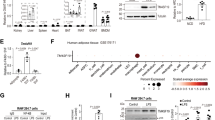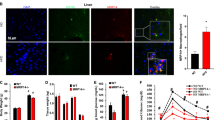Abstract
Macrophages consist of at least two subgroups, M1 and M2 (refs 1, 2, 3). Whereas M1 macrophages are proinflammatory and have a central role in host defence against bacterial and viral infections4,5, M2 macrophages are associated with responses to anti-inflammatory reactions, helminth infection, tissue remodelling, fibrosis and tumour progression6. Trib1 is an adaptor protein involved in protein degradation by interacting with COP1 ubiquitin ligase7. Genome-wide association studies in humans have implicated TRIB1 in lipid metabolism8,9,10. Here we show that Trib1 is critical for the differentiation of F4/80+MR+ tissue-resident macrophages—that share characteristics with M2 macrophages (which we term M2-like macrophages)—and eosinophils but not for the differentiation of M1 myeloid cells. Trib1 deficiency results in a severe reduction of M2-like macrophages in various organs, including bone marrow, spleen, lung and adipose tissues. Aberrant expression of C/EBPα in Trib1-deficient bone marrow cells is responsible for the defects in macrophage differentiation. Unexpectedly, mice lacking Trib1 in haematopoietic cells show diminished adipose tissue mass accompanied by evidence of increased lipolysis, even when fed a normal diet. Supplementation of M2-like macrophages rescues the pathophysiology, indicating that a lack of these macrophages is the cause of lipolysis. In response to a high-fat diet, mice lacking Trib1 in haematopoietic cells develop hypertriglyceridaemia and insulin resistance, together with increased proinflammatory cytokine gene induction. Collectively, these results demonstrate that Trib1 is critical for adipose tissue maintenance and suppression of metabolic disorders by controlling the differentiation of tissue-resident M2-like macrophages.
This is a preview of subscription content, access via your institution
Access options
Subscribe to this journal
Receive 51 print issues and online access
$199.00 per year
only $3.90 per issue
Buy this article
- Purchase on Springer Link
- Instant access to full article PDF
Prices may be subject to local taxes which are calculated during checkout




Similar content being viewed by others
References
Martinez, F. O., Helming, L. & Gordon, S. Alternative activation of macrophages: an immunologic functional perspective. Annu. Rev. Immunol. 27, 451–483 (2009)
Biswas, S. K. & Mantovani, A. Macrophage plasticity and interaction with lymphocyte subsets: cancer as a paradigm. Nature Immunol. 11, 889–896 (2010)
Mantovani, A. & Sica, A. Macrophages, innate immunity and cancer: balance, tolerance, and diversity. Curr. Opin. Immunol. 22, 231–237 (2010)
Takeuchi, O. & Akira, S. Pattern recognition receptors and inflammation. Cell 140, 805–820 (2010)
Medzhitov, R. Origin and physiological roles of inflammation. Nature 454, 428–435 (2008)
Sica, A. & Mantovani, A. Macrophage plasticity and polarization: in vivo veritas. J. Clin. Invest. 122, 787–795 (2012)
Yokoyama, T. et al. Trib1 links the MEK1/ERK pathway in myeloid leukemogenesis. Blood 116, 2768–2775 (2010)
Varbo, A., Benn, M., Tybjaerg-Hansen, A., Grande, P. & Nordestgaard, B. G. TRIB1 and GCKR polymorphisms, lipid levels, and risk of ischemic heart disease in the general population. Arterioscler. Thromb. Vasc. Biol. 31, 451–457 (2011)
Aung, L. H. et al. Association of the TRIB1 tribbles homolog 1 gene rs17321515 A>G polymorphism and serum lipid levels in the Mulao and Han populations. Lipids Health Dis. 10, 230 (2011)
Chambers, J. C. et al. Genome-wide association study identifies loci influencing concentrations of liver enzymes in plasma. Nature Genet. 43, 1131–1138 (2011)
Yamamoto, M. et al. Enhanced TLR-mediated NF-IL6 dependent gene expression by Trib1 deficiency. J. Exp. Med. 204, 2233–2239 (2007)
Jin, G. et al. Trib1 and Evi1 cooperate with Hoxa and Meis1 in myeloid leukemogenesis. Blood 109, 3998–4005 (2007)
Keeshan, K. et al. Tribbles homolog 2 inactivates C/EBPα and causes acute myelogenous leukemia. Cancer Cell 10, 401–411 (2006)
Du, K., Herzig, S., Kulkarni, R. N. & Montminy, M. TRB3: A tribbles homolog that inhibits Akt/PKB activation by insulin in liver. Science 300, 1574–1577 (2003)
Okamoto, H. et al. Genetic deletion of Trb3, the mammalian Drosophila tribbles homolog, displays normal hepatic insulin signaling and glucose homeostasis. Diabetes 56, 1350–1356 (2007)
Kohyama, M. et al. Role for Spi-C in the development of red pulp macrophages and splenic iron homeostasis. Nature 457, 318–321 (2009)
De Domenico, I., McVey Ward, D. & Kaplan, J. Regulation of iron acquisition and storage: consequences for iron-linked disorders. Nature Rev. Mol. Cell Biol. 9, 72–81 (2008)
Hong, S., Skaist, A. M., Wheelan, S. J. & Friedman, A. D. AP-1 protein induction during monopoiesis favors C/EBP: AP-1 heterodimers over C/EBP homodimerization and stimulates FosB transcription. J. Leukoc. Biol. 90, 643–651 (2011)
Odegaard, J. I. & Chawla, A. Alternative macrophage activation and metabolism. Annu. Rev. Pathol. 6, 275–297 (2011)
Lumeng, C. N., Bodzin, J. L. & Saltiel, A. R. Obesity induces a phenotypic switch in adipose tissue macrophage polarization. J. Clin. Invest. 117, 175–184 (2007)
Odegaard, J. I. et al. Macrophage-specific PPARγ controls alternative activation and improves insulin resistance. Nature 447, 1116–1120 (2007)
Reese, T. A. et al. Chitin induces accumulation in tissue of innate immune cells associated with allergy. Nature 447, 92–96 (2007)
Satoh, T. et al. The Jmjd3-Irf4 axis regulates M2 macrophage polarization and host responses against helminth infection. Nature Immunol. 11, 936–944 (2010)
Chawla, A., Nguyen, K. D. & Goh, Y. P. Macrophage-mediated inflammation in metabolic disease. Nature Rev. Immunol. 11, 738–749 (2011)
Gregor, M. F. & Hotamisligil, G. S. Inflammatory mechanisms in obesity. Annu. Rev. Immunol. 29, 415–445 (2011)
Hotamisligil, G. S. Inflammation and metabolic disorders. Nature 444, 860–867 (2006)
Wellen, K. E. & Hotamisligil, G. S. Obesity-induced inflammatory changes in adipose tissue. J. Clin. Invest. 112, 1785–1788 (2003)
Wu, D. et al. Eosinophils sustain adipose alternatively activated macrophages associated with glucose homeostasis. Science 332, 243–247 (2011)
Odegaard, J. I. et al. Alternative M2 activation of Kupffer cells by PPARδ ameliorates obesity-induced insulin resistance. Cell Metab. 7, 496–507 (2008)
Ricardo-Gonzalez, R. R. et al. IL-4/STAT6 immune axis regulates peripheral nutrient metabolism and insulin sensitivity. Proc. Natl Acad. Sci. USA 107, 22617–22622 (2010)
Acknowledgements
We thank I. Shimomura and Y. Miyata for providing us with the key protocols for the metabolic experiments; T. Kitamura for providing the PlatE cells; M. Higa, H. Tanaka, N. Miyamoto, K. Miura, D. Ori, T. Uehata and K. Kuniyoshi for assistance with the experiments; and T. Kawai, S. Uematsu, T. Saitoh and Y. Kumagai for discussions. We also thank E. Kamada and M. Kageyama for secretarial assistance, and N. Umano, Y. Matsumoto and M. Kumagai for technical assistance. This work was supported by the Special Coordination Funds of the Japanese Ministry of Education, Culture, Sports, Science and Technology, and the Ministry of Health, Labour and Welfare in Japan, the Japan Society for the Promotion of Science through the Funding Program for World-Leading Innovative R&D on Science and Technology (FIRST Program).
Author information
Authors and Affiliations
Contributions
T.S. designed and performed the experiments and wrote the manuscript. H.K., H.N. and N. Takakura performed the colony-forming assays. M.Y. generated the Trib1−/−, Trib2−/− and Trib3−/− mice. N. Takemura helped with experiments. K.N. performed microarray analysis. Y.Y. performed the MRI experiments. E.M. performed the histological analyses. O.T. and S.A. designed experiments and wrote the manuscript. S.A. supervised the project.
Corresponding author
Ethics declarations
Competing interests
The authors declare no competing financial interests.
Supplementary information
Supplementary Figures
This file contains Supplementary Figures 1-24. (PDF 3629 kb)
Rights and permissions
About this article
Cite this article
Satoh, T., Kidoya, H., Naito, H. et al. Critical role of Trib1 in differentiation of tissue-resident M2-like macrophages. Nature 495, 524–528 (2013). https://doi.org/10.1038/nature11930
Received:
Accepted:
Published:
Issue Date:
DOI: https://doi.org/10.1038/nature11930
This article is cited by
-
Physiology and diseases of tissue-resident macrophages
Nature (2023)
-
Heterogeneity of adipose tissue-resident macrophages-beyond M1/M2 paradigm
Diabetology International (2023)
-
The gut–liver axis in sepsis: interaction mechanisms and therapeutic potential
Critical Care (2022)
-
Genetic and cytometric analyses of subcutaneous adipose tissue in patients with hemophilia and HIV-associated lipodystrophy
AIDS Research and Therapy (2022)
-
New insights into M1/M2 macrophages: key modulators in cancer progression
Cancer Cell International (2021)
Comments
By submitting a comment you agree to abide by our Terms and Community Guidelines. If you find something abusive or that does not comply with our terms or guidelines please flag it as inappropriate.



